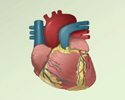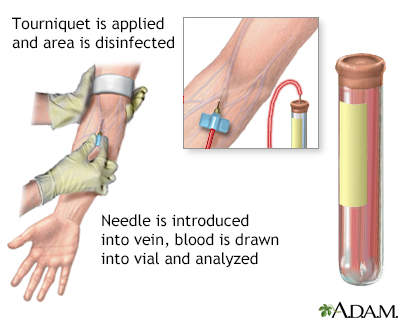LDL test
The low-density lipoprotein (LDL) test is a blood test to measure the amount of LDL cholesterol in your blood. LDL is a type of fat (lipid) in your blood.
LDL is called "bad" cholesterol because it can build up and form fatty deposits (plaques) in the walls of your arteries.
Build up and form fatty deposits
Atherosclerosis, sometimes called "hardening of the arteries," occurs when fat, cholesterol, and other substances build up in the walls of arteries. ...

The LDL test is often done as part of a lipid profile, which measures other fats in your blood:
Lipid profile
Lipids are fatty, wax-like substances found in the body. Your body needs lipids for proper body functions, growth, and energy. Two important types ...

- Total cholesterol
Total cholesterol
Total cholesterol is a blood test to measure all types of cholesterol in your blood. Cholesterol is a fatty, wax-like substance found in all parts o...
 ImageRead Article Now Book Mark Article
ImageRead Article Now Book Mark Article - HDL cholesterol
HDL cholesterol
The high-density lipoprotein (HDL) test is a blood test to measure the amount of HDL cholesterol in your blood. HDL is a type of fat (lipid) in your...
 ImageRead Article Now Book Mark Article
ImageRead Article Now Book Mark Article - Triglycerides
Triglycerides
The triglyceride level is a blood test to measure the amount of triglycerides in your blood. Triglycerides are a type of fat. Your body makes some t...
 ImageRead Article Now Book Mark Article
ImageRead Article Now Book Mark Article - Very low-density lipoprotein cholesterol (VLDL cholesterol)
VLDL cholesterol
VLDL stands for very low density lipoprotein. Lipoproteins are made up of cholesterol, triglycerides, and proteins. They move cholesterol, triglyce...
 ImageRead Article Now Book Mark Article
ImageRead Article Now Book Mark Article
How the Test is Performed
A blood sample is needed. Most of the time, blood is drawn from a vein located on the inside of the elbow or the back of the hand.
Blood is drawn from a vein
Venipuncture is the collection of blood from a vein. It is most often done for laboratory testing.

How to Prepare for the Test
You should not eat for 9 to 12 hours before the test.
Alcohol and some medicines can interfere with blood test results.
- Make sure your health care provider knows what medicines you take, including over-the-counter medicines and supplements.
- Your provider will tell you if you need to stop taking any medicines before you have this test.
- Do not stop or change your medicines without talking to your provider first.
How the Test will Feel
You may feel slight pain or a sting when the needle is inserted. You may also feel some throbbing at the site after the blood is drawn.
Why the Test is Performed
LDL cholesterol is usually measured together with other blood fats. Often it is done to help determine your risk of developing heart disease.
High LDL increases your risk for:
- Heart disease
Heart disease
Coronary heart disease is a narrowing of the blood vessels that supply blood and oxygen to the heart. Coronary heart disease (CHD) is also called co...
 ImageRead Article Now Book Mark Article
ImageRead Article Now Book Mark Article - Peripheral artery disease
Peripheral artery disease
Peripheral artery disease (PAD) is a condition of the blood vessels that supply the legs and feet. It occurs due to narrowing of the arteries in the...
 ImageRead Article Now Book Mark Article
ImageRead Article Now Book Mark Article - Heart attack
Heart attack
Most heart attacks are caused by a blood clot that blocks one of the coronary arteries. The coronary arteries bring blood and oxygen to the heart. ...
 ImageRead Article Now Book Mark Article
ImageRead Article Now Book Mark Article - Stroke
Stroke
A stroke occurs when blood flow to a part of the brain stops. A stroke is sometimes called a "brain attack. " If blood flow is cut off for longer th...
 ImageRead Article Now Book Mark Article
ImageRead Article Now Book Mark Article
Normal Results
You want your LDL to be low. In general, lower is better.
Your LDL is always considered to be too high if it is 190 mg/dL (4.92 mmol/L) or higher.
General targets for children are less than 110 mg/dL (2.85 mmol/L) (lower numbers are better).
Levels from 70 to 189 mg/dL (1.81 to 4.90 mmol/L) are most often considered too high if:
- You have diabetes and are between ages 40 to 75
- You have diabetes and a high risk of heart disease
- You have a medium or high risk of heart disease
- You have heart disease, history of a stroke, or poor circulation to your legs
In these circumstances, your provider will often recommend medicine to lower your LDL cholesterol level.
Health care providers have traditionally set a target level for your LDL cholesterol if you are being treated with medicines to lower your cholesterol.
- Some newer guidelines now suggest that providers no longer need to target a specific number for your LDL cholesterol. Higher strength medicines are used for the highest risk patients.
- However, some guidelines still recommend using specific targets, including lowering LDL to less than 55 mg/dL in very high-risk patients.
Normal value ranges may vary slightly among different laboratories. Talk to your provider about the meaning of your specific test results.
What Abnormal Results Mean
A higher-than-normal LDL may be due to:
- Eating a diet high in saturated fats
- Lack of physical activity
- Being overweight or having obesity
Being overweight
Overweight and obesity mean having a weight than is higher than what is healthy for a given height. A person may be overweight from extra muscle, bo...
 ImageRead Article Now Book Mark Article
ImageRead Article Now Book Mark ArticleHaving obesity
Obesity means weighing more than what is healthy for a given height. Obesity is a serious, chronic disease. It can lead to other health problems, i...
 ImageRead Article Now Book Mark Article
ImageRead Article Now Book Mark Article - Diabetes
Diabetes
Diabetes is a long-term (chronic) disease in which the body cannot regulate the amount of sugar in the blood.
 ImageRead Article Now Book Mark Article
ImageRead Article Now Book Mark Article - Metabolic syndrome
Metabolic syndrome
Metabolic syndrome is a name for a group of risk factors that occur together and increase the chance of having coronary artery disease, stroke, and t...
 ImageRead Article Now Book Mark Article
ImageRead Article Now Book Mark Article - Certain medicines
- Underactive thyroid gland (hypothyroid)
Hypothyroid
Hypothyroidism is a condition in which the thyroid gland does not make enough thyroid hormone. This condition is often called underactive thyroid....
 ImageRead Article Now Book Mark Article
ImageRead Article Now Book Mark Article - Disorder passed down through families in which there are high amounts of cholesterol and triglycerides in the blood (familial combined hyperlipidemia)
Familial combined hyperlipidemia
Familial combined hyperlipidemia is a disorder that is passed down through families. It causes high blood cholesterol and triglyceride levels....
 ImageRead Article Now Book Mark Article
ImageRead Article Now Book Mark Article - Kidney or liver disease
If your LDL level is high, your provider may recommend changes in your lifestyle such as:
Lifestyle
Your body needs cholesterol to work well. But cholesterol levels that are too high can harm you. In the US, blood cholesterol is most often measured...

- Eating a healthy diet
- Losing weight (if you are overweight or have obesity)
- Getting regular exercise
- Quitting smoking
- Avoiding alcohol
You may also need medicine to lower your LDL levels if you have diabetes or are at risk of heart disease. While taking medicines to lower your LDL level, you should continue the lifestyle changes.
Medicine to lower your LDL levels
Your body needs cholesterol to work properly. But extra cholesterol in your blood causes deposits to build up on the inside walls of your blood vess...

Risks
There is little risk involved with having your blood taken. Veins and arteries vary in size from one person to another and from one side of the body to the other. Taking blood from some people may be more difficult than from others.
Other risks associated with having blood drawn are slight, but may include:
- Excessive bleeding
- Fainting or feeling lightheaded
Fainting
Fainting is a brief loss of consciousness due to a drop in blood flow to the brain. The episode most often lasts less than a couple of minutes and y...
Read Article Now Book Mark Article - Multiple punctures to locate veins
- Hematoma (blood buildup under the skin)
Hematoma
Bleeding into the skin can occur from broken blood vessels that form tiny red dots (called petechiae). Blood also can collect under the tissue in la...
 ImageRead Article Now Book Mark Article
ImageRead Article Now Book Mark Article - Infection (a slight risk any time the skin is broken)
Considerations
Certain medicines, pregnancy, infection, and some medical conditions can affect test results.
Reviewed By
Michael A. Chen, MD, PhD, Associate Professor of Medicine, Division of Cardiology, Harborview Medical Center, University of Washington Medical School, Seattle, WA. Also reviewed by David C. Dugdale, MD, Medical Director, Brenda Conaway, Editorial Director, and the A.D.A.M. Editorial team.
Bredefeld CL, Lau R, Hussain MM. Lipids and dyslipoproteinemia. In: McPherson RA, Pincus MR, eds. Henry's Clinical Diagnosis and Management by Laboratory Methods. 24th ed. Philadelphia, PA: Elsevier; 2022:chap 18.
Genest J, Mora S, Libby P. Lipoprotein disorders and cardiovascular disease. In: Libby P, Bonow RO, Mann DL, Tomaselli, GF, Bhatt DL, Solomon SD, eds. Braunwald's Heart Disease: A Textbook of Cardiovascular Medicine. 12th ed. Philadelphia, PA: Elsevier; 2022:chap 27.
Grundy SM, Stone NJ, Bailey AL, et al. 2018 AHA/ACC/AACVPR/AAPA/ABC/ACPM/ADA/AGS/APhA/ASPC/NLA/PCNA Guideline on the management of blood cholesterol: a report of the American College of Cardiology/American Heart Association Task Force on clinical practice guidelines. Circulation. 2019;139(25):e1082-e1143. PMID: 30586774 pubmed.ncbi.nlm.nih.gov/30586774/.
Mora S, Libby P, Ridker PM. Primary prevention of cardiovascular disease. In: Libby P, Bonow RO, Mann DL, Tomaselli, GF, Bhatt DL, Solomon SD, eds. Braunwald's Heart Disease: A Textbook of Cardiovascular Medicine. 12th ed. Philadelphia, PA: Elsevier; 2022:chap 25.
Robinson JG. Disorders of lipid metabolism. In: Goldman L, Cooney KA, eds. Goldman-Cecil Medicine. 27th ed. Philadelphia, PA: Elsevier; 2024:chap 190.





 All rights reserved.
All rights reserved.